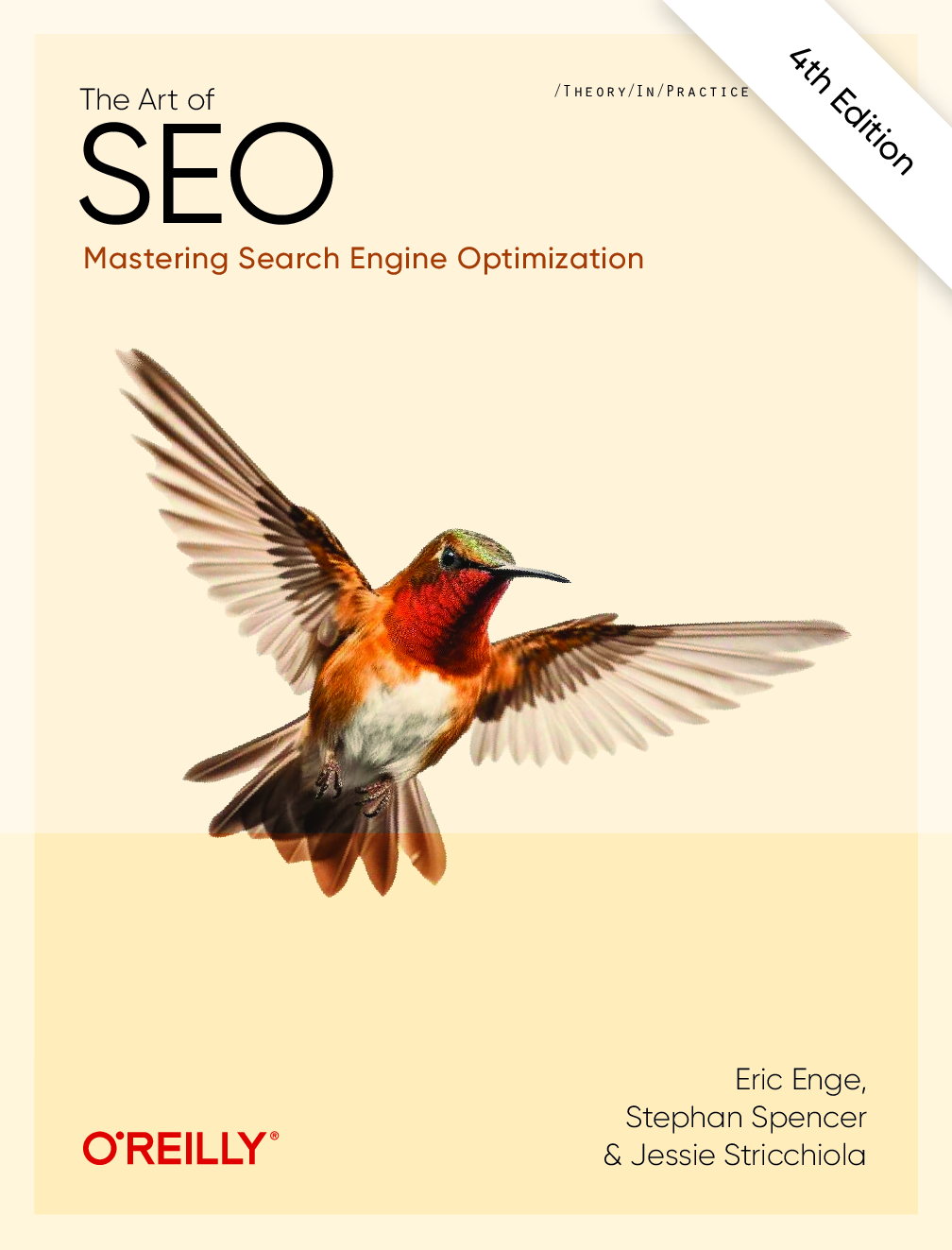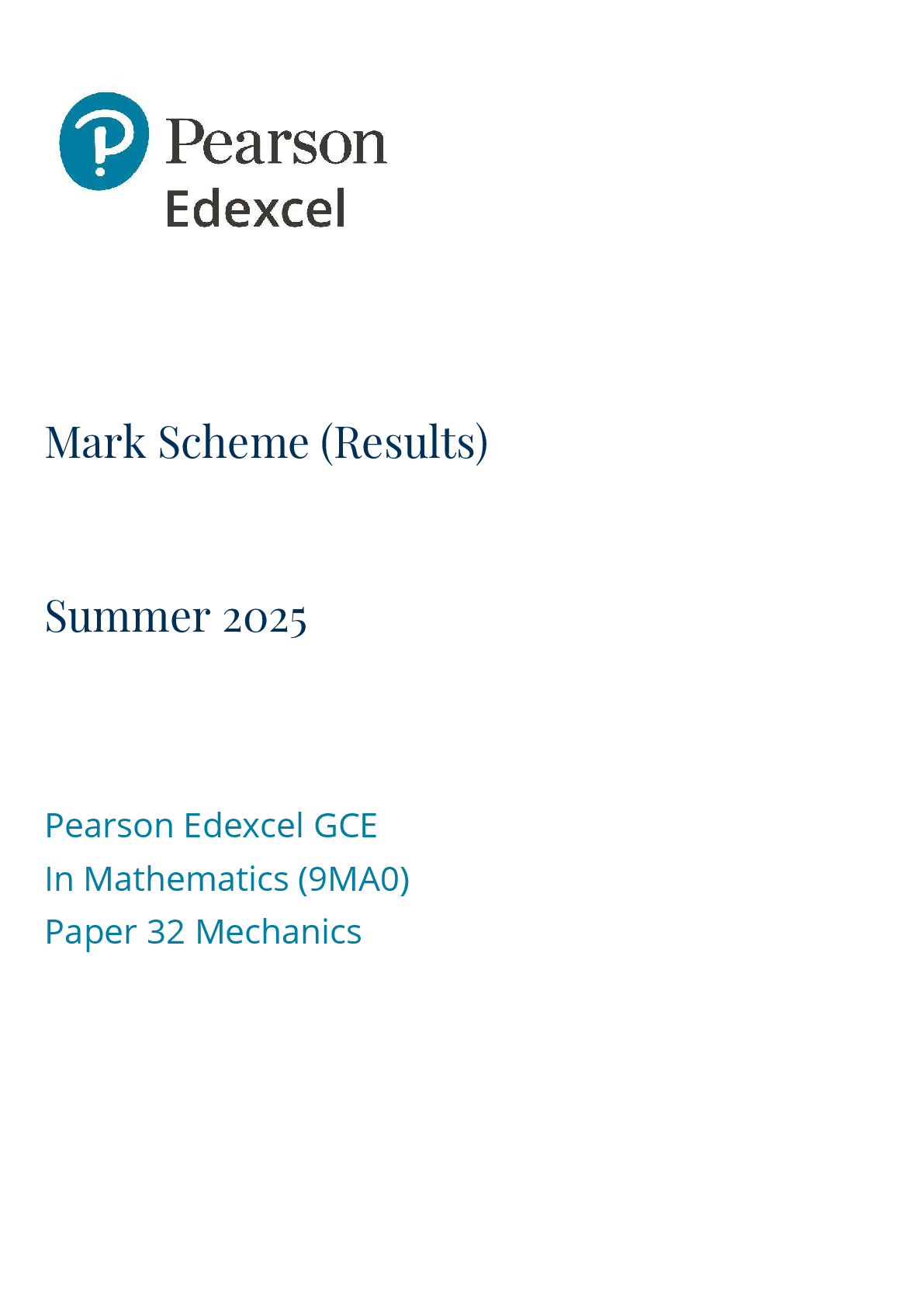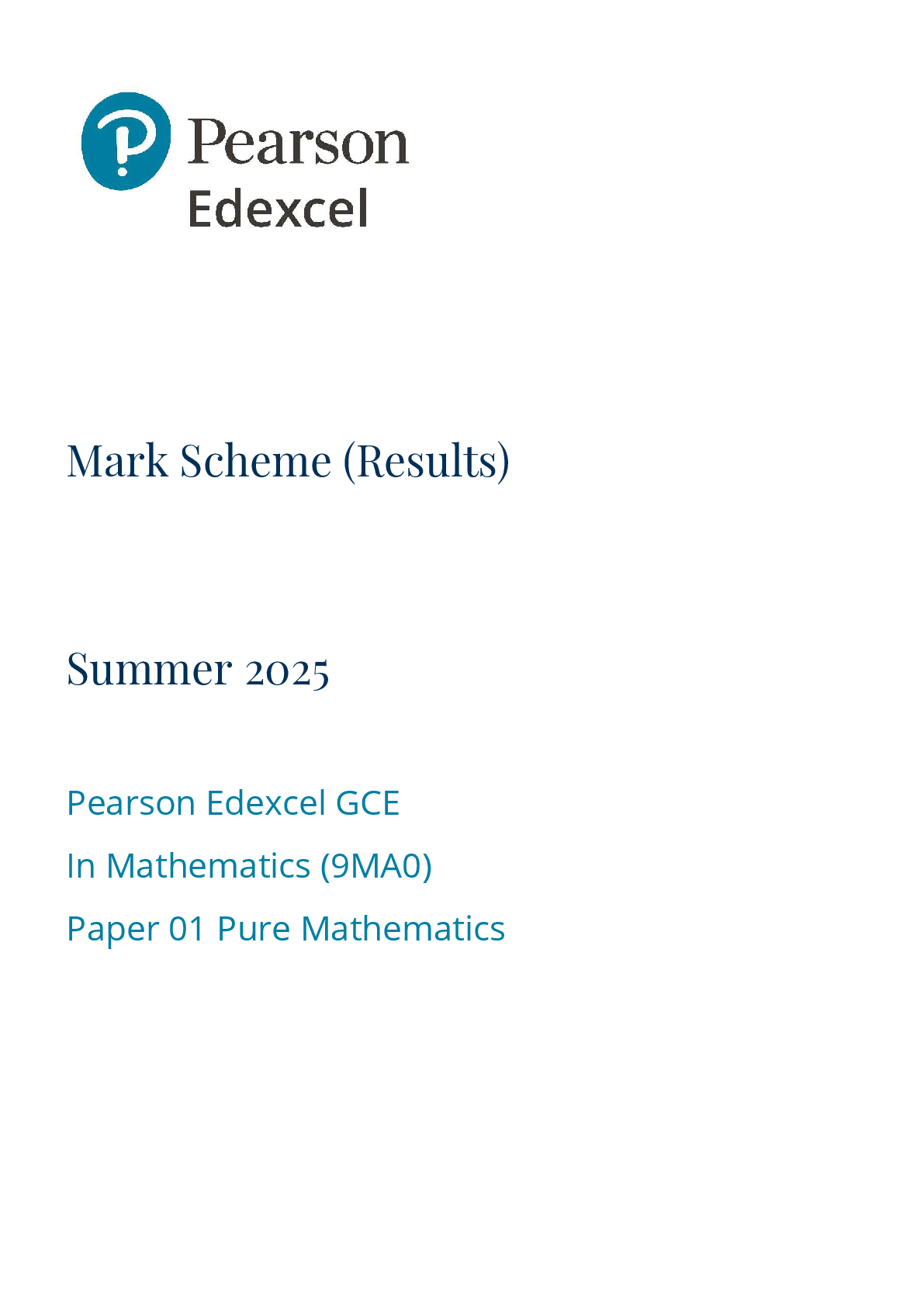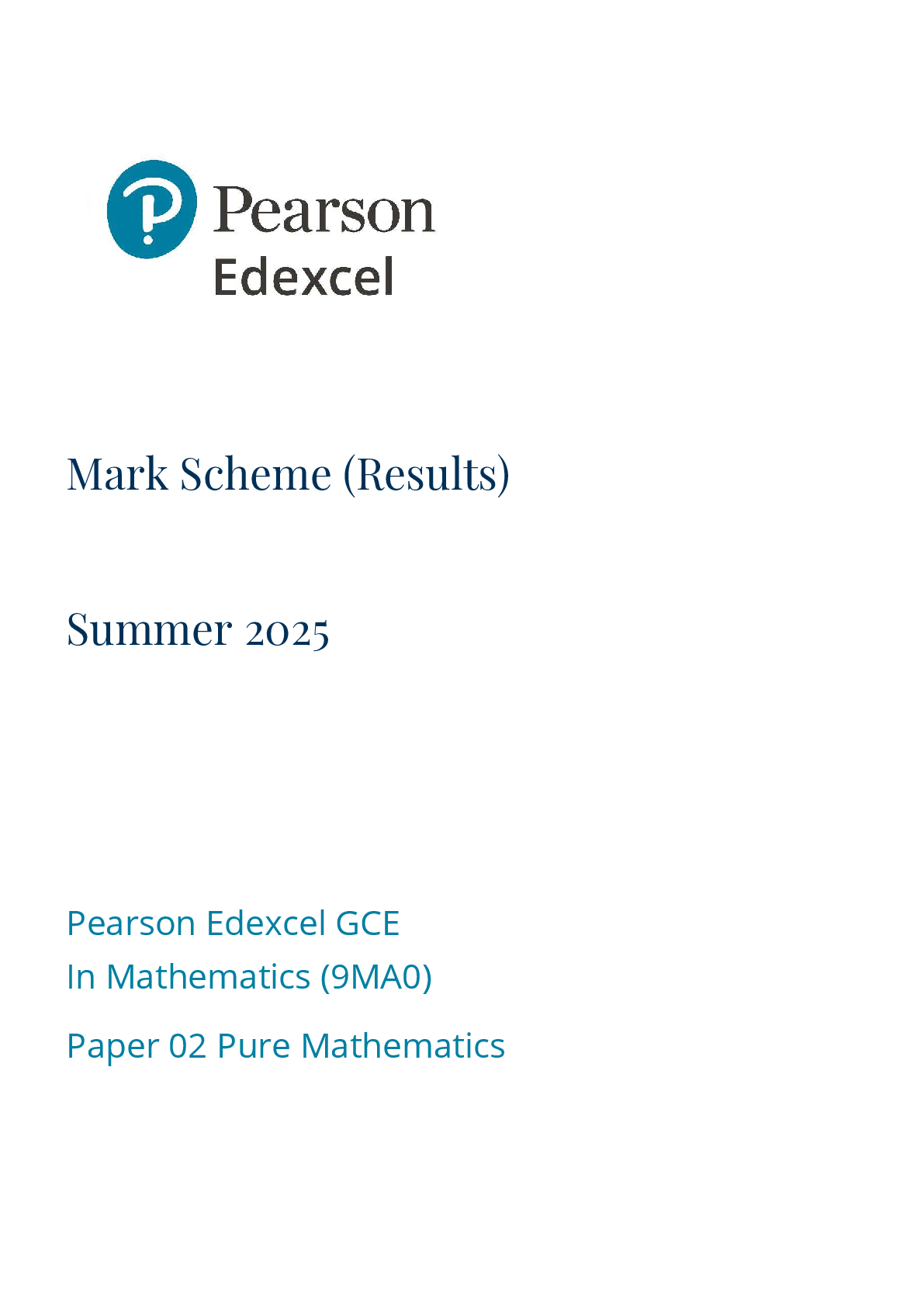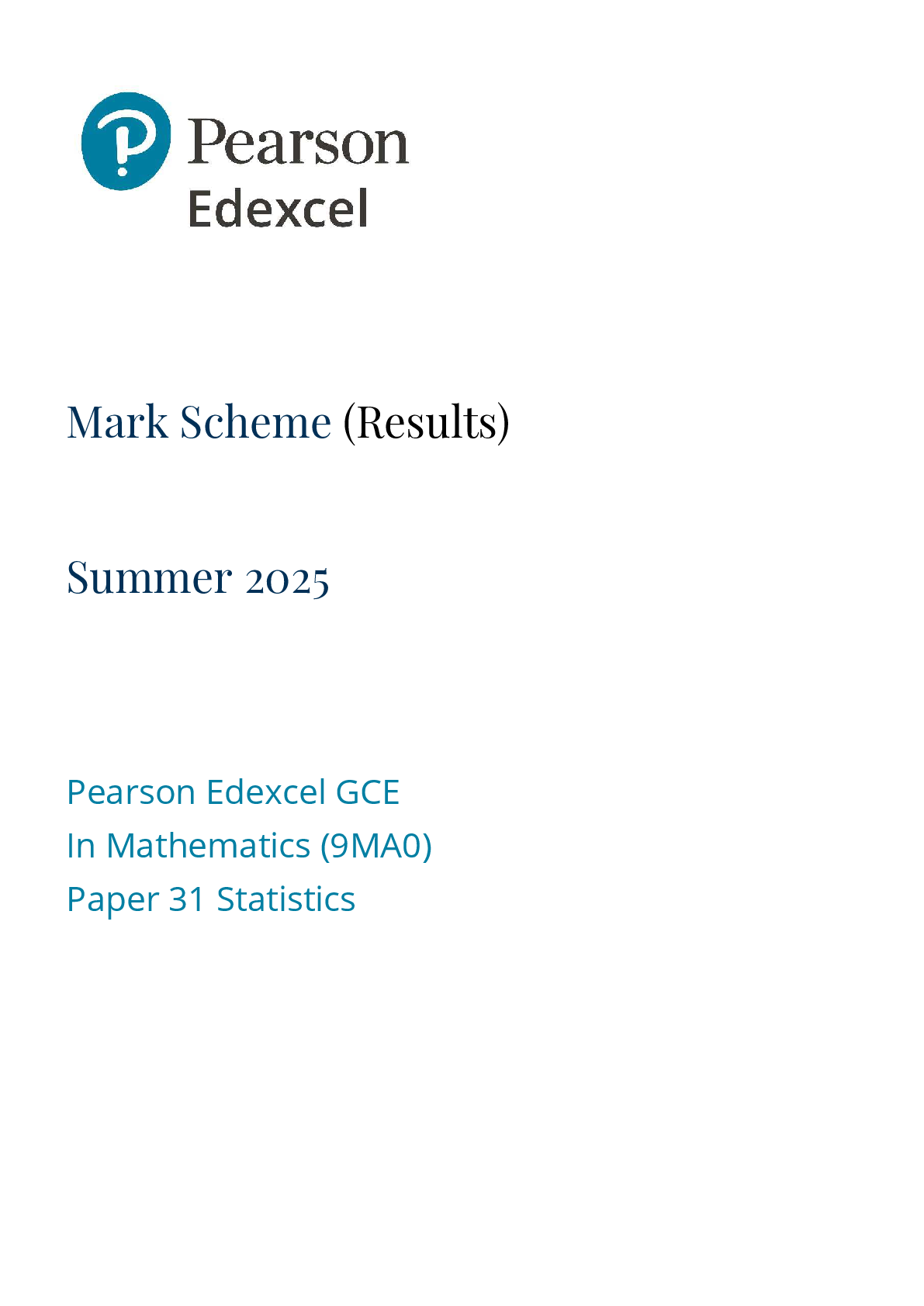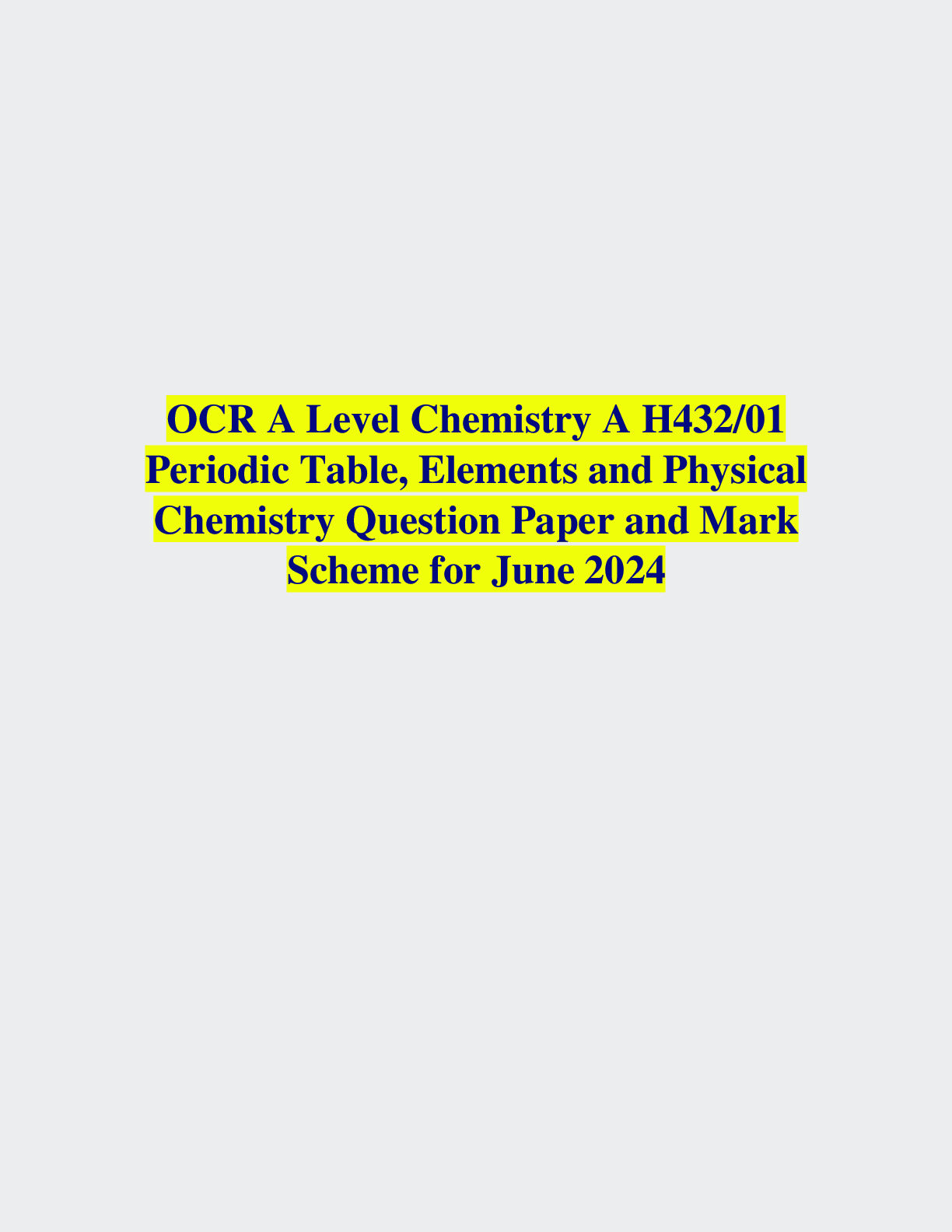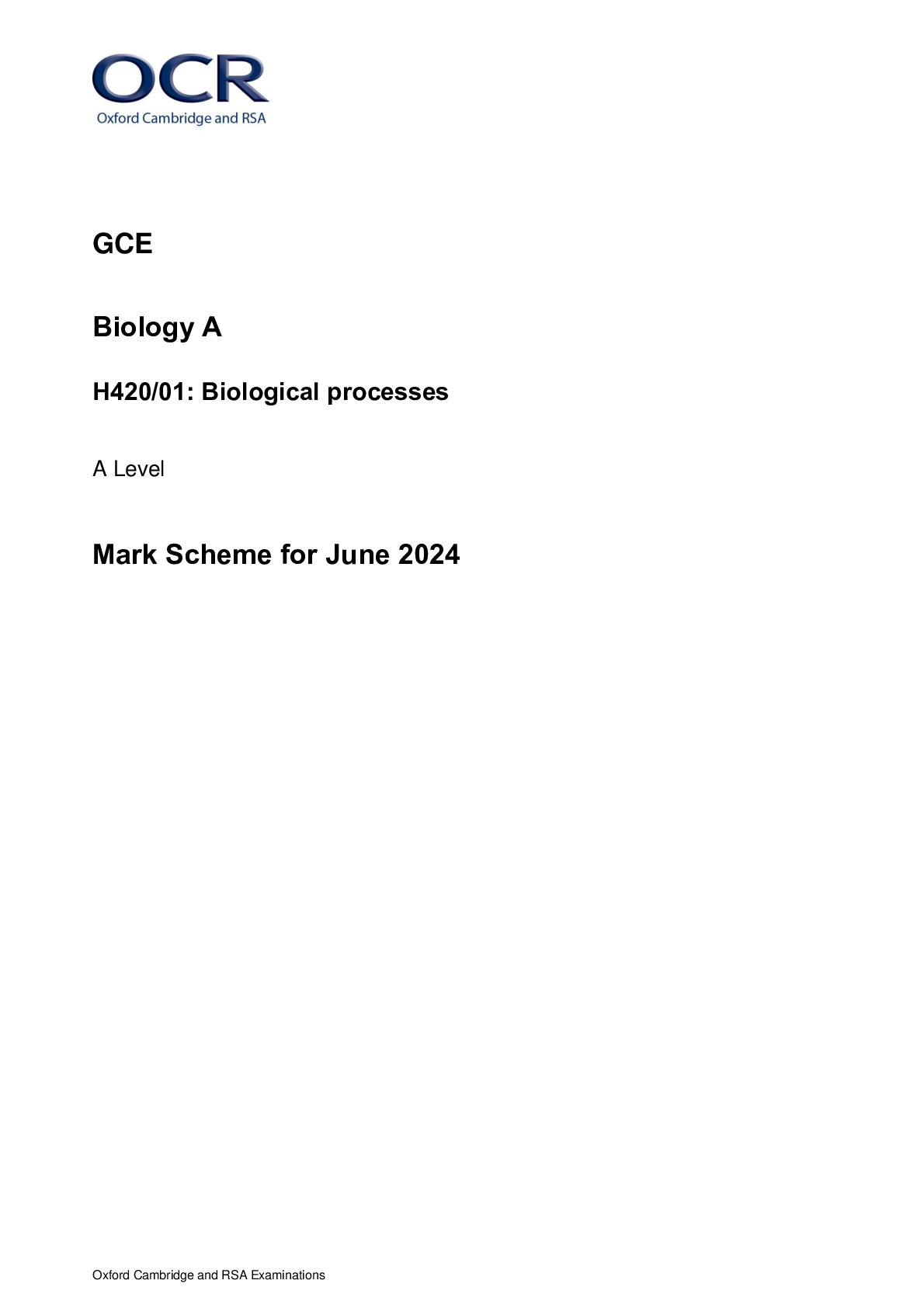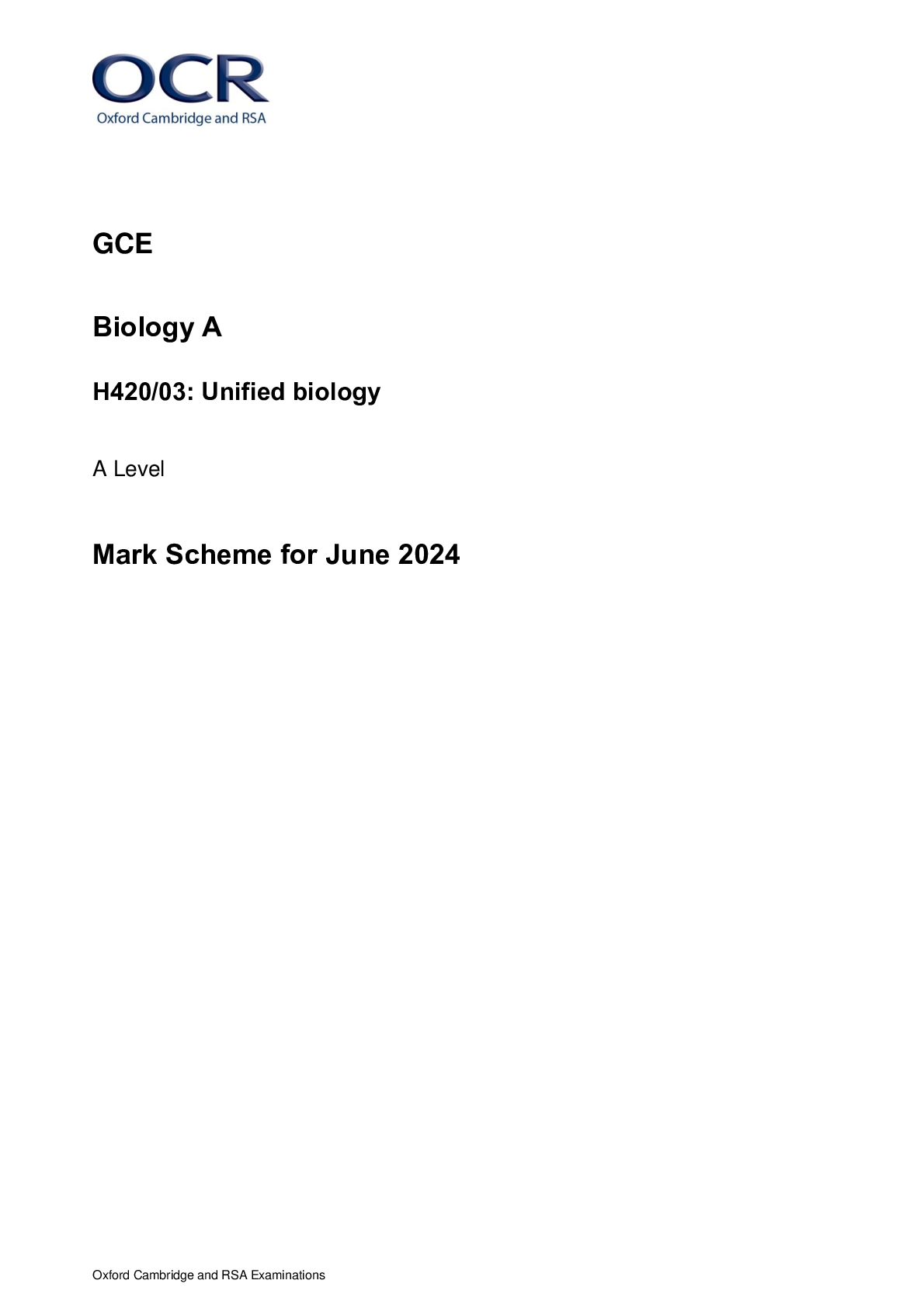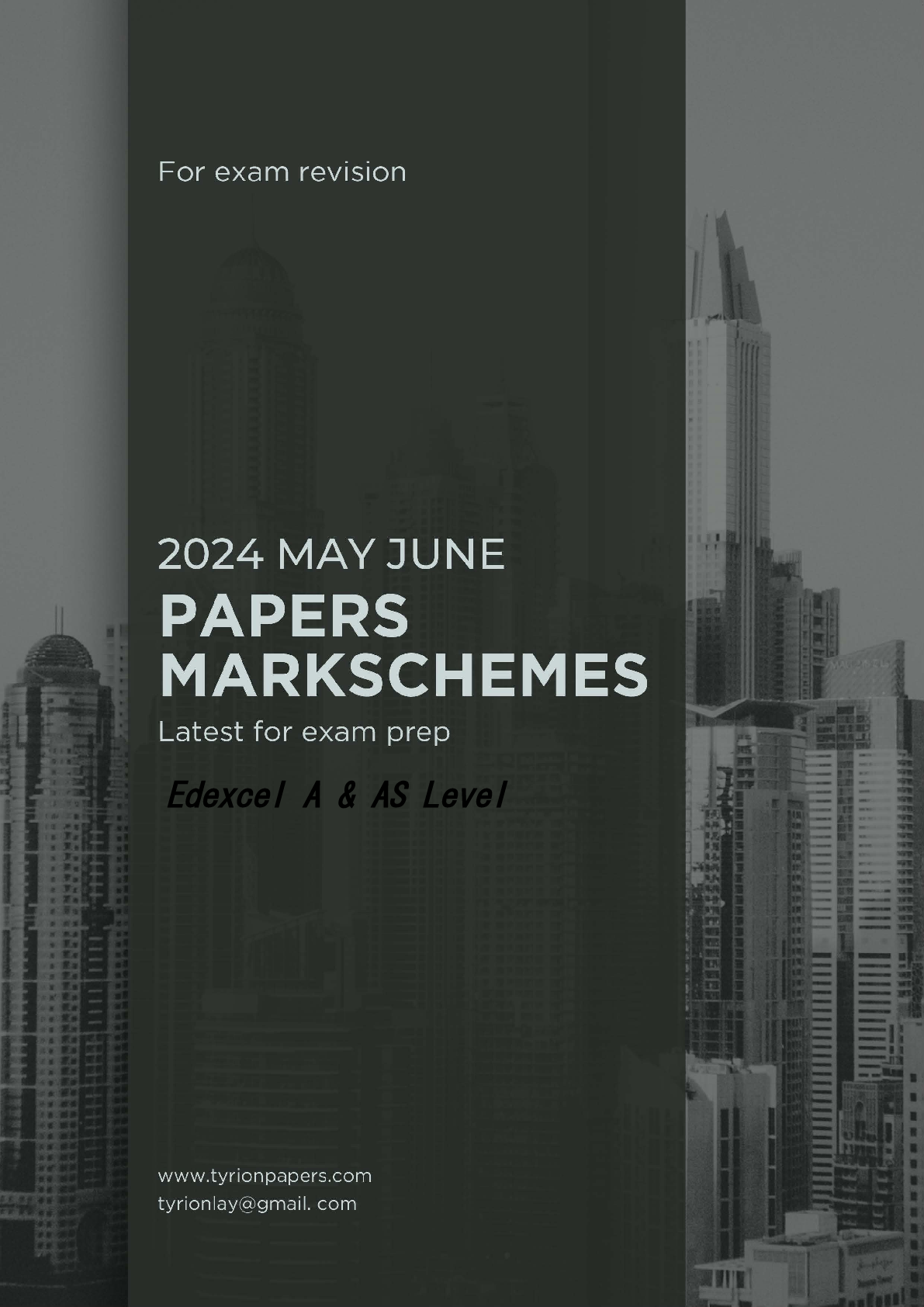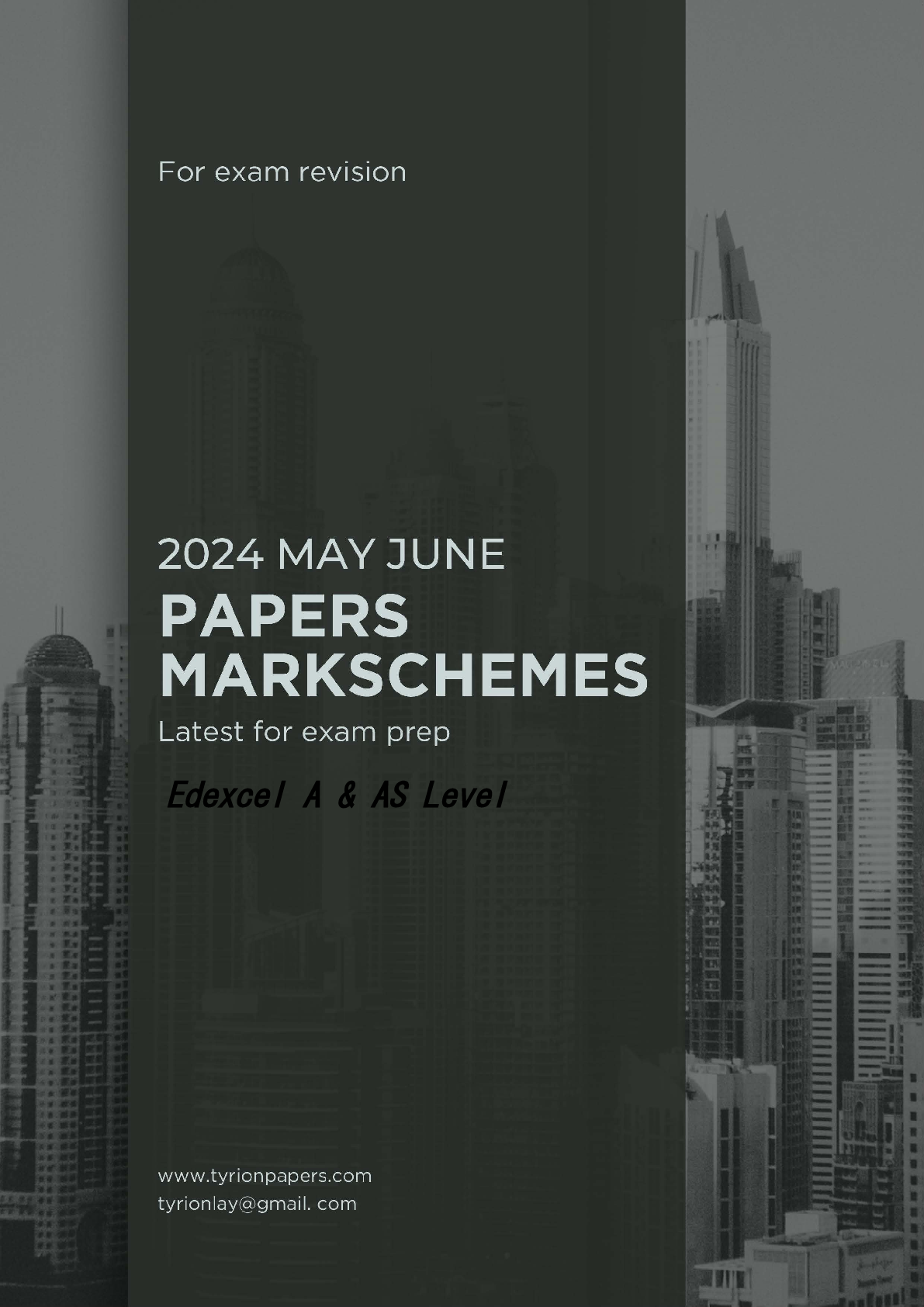Biology > A-Level Mark Scheme > AQA A Level Biology 7402/2 Paper 2 Mark Scheme June 2021 Version 1.0 Final (All)
AQA A Level Biology 7402/2 Paper 2 Mark Scheme June 2021 Version 1.0 Final
Document Content and Description Below
AQA A-Level Biology 7402/2 Paper 2 Mark Scheme June 2021 Version 1.0 Final / AQA A-Level Biology 7402-2 Paper 2 Mark Scheme June 2021 Version 1.0 Final / AQA A-Level Biology Paper 2 Mark Scheme June 2 ... 021 Version 1.0 Final A-level BIOLOGY 7402/2 Paper 2 Mark scheme June 2021 Version: 1.0 Final AQA MARK SCHEME – A-LEVEL BIOLOGY – 7402/2 – JUNE 2021 2 Mark schemes are prepared by the Lead Assessment Writer and considered, together with the relevant questions, by a panel of subject teachers. This mark scheme includes any amendments made at the standardisation events which all associates participate in and is the scheme which was used by them in this examination. The standardisation process ensures that the mark scheme covers the students’ responses to questions and that every associate understands and applies it in the same correct way. As preparation for standardisation each associate analyses a number of students’ scripts. Alternative answers not already covered by the mark scheme are discussed and legislated for. If, after the standardisation process, associates encounter unusual answers which have not been raised they are required to refer these to the Lead Examiner. It must be stressed that a mark scheme is a working document, in many cases further developed and expanded on the basis of students’ reactions to a particular paper. Assumptions about future mark schemes on the basis of one year’s document should be avoided; whilst the guiding principles of assessment remain constant, details will change, depending on the content of a particular examination paper. Further copies of this mark scheme are available from aqa MARK SCHEME – A-LEVEL BIOLOGY – 7402/2 – JUNE 2021 3 Level of response marking instructions Level of response mark schemes are broken down into levels, each of which has a descriptor. The descriptor for the level shows the average performance for the level. There are marks in each level. Before you apply the mark scheme to a student’s answer read through the answer and annotate it (as instructed) to show the qualities that are being looked for. You can then apply the mark scheme. Step 1 Determine a level Start at the lowest level of the mark scheme and use it as a ladder to see whether the answer meets the descriptor for that level. The descriptor for the level indicates the different qualities that might be seen in the student’s answer for that level. If it meets the lowest level then go to the next one and decide if it meets this level, and so on, until you have a match between the level descriptor and the answer. With practice and familiarity you will find that for better answers you will be able to quickly skip through the lower levels of the mark scheme. When assigning a level you should look at the overall quality of the answer and not look to pick holes in small and specific parts of the answer where the student has not performed quite as well as the rest. If the answer covers different aspects of different levels of the mark scheme you should use a best fit approach for defining the level and then use the variability of the response to help decide the mark within the level, ie if the response is predominantly level 3 with a small amount of level 4 material it would be placed in level 3 but be awarded a mark near the top of the level because of the level 4 content. Step 2 Determine a mark Once you have assigned a level you need to decide on the mark. The descriptors on how to allocate marks can help with this. The exemplar materials used during standardisation will help. There will be an answer in the standardising materials which will correspond with each level of the mark scheme. This answer will have been awarded a mark by the Lead Examiner. You can compare the student’s answer with the example to determine if it is the same standard, better or worse than the example. You can then use this to allocate a mark for the answer based on the Lead Examiner’s mark on the example. You may well need to read back through the answer as you apply the mark scheme to clarify points and assure yourself that the level and the mark are appropriate. Indicative content in the mark scheme is provided as a guide for examiners. It is not intended to be exhaustive and you must credit other valid points. Students do not have to cover all of the points mentioned in the Indicative content to reach the highest level of the mark scheme. An answer which contains nothing of relevance to the question must be awarded no marks. MARK SCHEME – A-LEVEL BIOLOGY – 7402/2 – JUNE 2021 4 Question Marking Guidance Mark Comments 01.1 1.Phosphorylation of glucose using ATP; 2.Oxidation of triose phosphate to pyruvate; 3.Net gain of ATP; 4.NAD reduced; 4 max Accept all mark points in diagrams. 2.Accept removal ofhydrogen from triosephosphate foroxidation. 3.Accept anydescription thatindicates a net gaine.g., 4 produced, 2used. 4.AcceptNADH/NADH2/NADH+H+ produced. Question Marking Guidance Mark Comments 01.2 1.Less/no reduced NAD/coenzymes OR Fewer/no hydrogens/electrons removed (andpassed to electron transfer chain); 2.Oxygen is the final/terminal (electron) acceptor; 2 1.Accept less/no FADreduced. MARK SCHEME – A-LEVEL BIOLOGY – 7402/2 – JUNE 2021 5 Question Marking Guidance Mark Comments 02.1 1. Higher concentration of potassium ions inside and higher concentration of sodium ions outside (the neurone) OR potassium ions diffuse out OR sodium ions diffuse in; 2. (Membrane) more permeable to potassium ions (leaving than sodium ions entering) OR (Membrane) less permeable to sodium ions (entering than potassium ions leaving); 3. Sodium ions (actively) transported out and potassium ions in; 3 1. Accept ‘more’ for ‘higher concentration’. 1. Accept ‘sodium ions can’t diffuse in (due to alternative explanation). 2. Accept for ‘less permeable to sodium ions’ is ‘impermeable to sodium ions’ or ‘sodium gates/channels are closed’ (alternative explanation). 1, 2 and 3 reference to ions or Na+ and K+ is required. If mentioned once allow for all mark points. 1, 2 and 3. If an answer provides two or three of these mark points without any reference to ions – award one maximum mark. 3. Accept 3 Na+ out and 2 K+ in but reject if numbers used are incorrect. Question Marking Guidance Mark Comments 02.2 1. Myelination provides (electrical) insulation; 2. (In myelinated) saltatory (conduction) OR (In myelinated) depolarisation at nodes (of Ranvier); 3. In non-myelinated depolarisation occurs along whole/length (of axon); 3 1. Reject thermal insulation. 1. Accept description of (electrical) insulation. 3. Accept action potentials for depolarisation. 2 and 3. ‘Messages’ or ‘signals’ disqualifies first of these marks credited. MARK SCHEME – A-LEVEL BIOLOGY – 7402/2 – JUNE 2021 6 Question Marking Guidance Mark Comments 02.3 1. No/less ATP produced; 2. No/less active transport OR Sodium/potassium pump inhibited; 3. Electrochemical gradient not maintained OR (Facilitated) diffusion of ions causes change to 0 mV OR (Results in) same concentration of (sodium and potassium) ions (either side of membrane) OR No net movement of (sodium and potassium) ions; 3 2. Accept Na+ not/fewer moved out and K+ not/fewer moved in. 3. Accept reaches electrical equilibrium/balance. 3. Accept concentration gradient of sodium and potassium ions not maintained. MARK SCHEME – A-LEVEL BIOLOGY – 7402/2 – JUNE 2021 7 Question Marking Guidance Mark Comments 03.1 1. Tip produces IAA; 2. IAA diffuses (into shoot); 3. (More) elongation of cells on one side (than other); 3 1. Accept source/release for produces but ignore contains/stores IAA. 1 and 2. Accept auxin for IAA. 2. Accept IAA diffuses down. 3. Accept (more) elongation of cells on left side. 3. Reject any reference to shaded/dark side or away from light. Question Marking Guidance Mark Comments 03.2 1. Size of shoot/tip; 2. Number of shoot tips; 3. Size/type of agar (block); 4. (Shoots) at same stage of growth/development; 5. Time (period) tips kept on agar OR Time (period) agar/block kept on (cut shoot) OR Time (period shoots) kept in dark; 6. Temperature; 7. (Repeat several times and) calculate a mean; 8. Compare/read degree of curvature (on calibration curve) to determine (IAA) concentration OR Higher the degree of curvature the higher the IAA concentration; 5 max Mark points 1 to 6 = max 3. 1 to 6. Ignore pH, species, carbon dioxide, humidity, nutrients, water and light. 3. Accept ‘amount of agar’. 4. Accept (Shoots/plants) are same age. MARK SCHEME – A-LEVEL BIOLOGY – 7402/2 – JUNE 2021 8 Question Marking Guidance Mark Comments 03.3 1. (IAA) is not broken down by light OR (IAA) is produced in the dark OR Light/dark does not affect (IAA) production; 2. (IAA) moves away from light OR (IAA) moves to shaded side; 2 2. IAA accumulates on shaded side is not enough on its own, idea of movement is required. Question Marking Guidance Mark Comments 04.1 1. Males have one allele; 2. Females need two recessive alleles OR Females must be homozygous recessive OR Females could have dominant and recessive alleles OR Females could be heterozygous/carriers; 2 1 Accept males only need one allele. 1 and 2. Ignore references to X and Y chromosomes. 1 and 2. Accept r as recessive allele and R as dominant allele. If no reference to allele, accept for one mark male needs one recessive gene whereas females need two recessive genes. Question Marking Guidance Mark Comments 04.2 1. Box 2. All females red-eyed, all males white-eyed. 1 Reject if more than one box with tick. Ignore crossed-out ticks. Question Marking Guidance Mark Comments 04.3 1. The (two) genes are linked OR Autosomal linkage; 3 1. Accept that the genes are on the same chromosome. MARK SCHEME – A-LEVEL BIOLOGY – 7402/2 – JUNE 2021 9 2. No crossing over (occurs) OR (Linked) genes are close together; 3. No Gl and no gL (gametes produced) OR No Ggll and no ggLl (offspring produced) OR Only GL and gl (gametes produced); 1. Accept ‘Alleles are linked’ (accept symbols for alleles) but reject if context suggests alleles of the ‘same gene’. 2. Accept crossing over less likely to occur. 1 2, and 3. Ignore reference to independent assortment. Question Marking Guidance Mark Comments 04.4 1. Correct answer of 8 × 1010 = 3 marks;;; 2. Correct answer not in standard form = 2 marks OR 1.6 × 1013 = 2 mark OR 1.6 × 1011 = 2 mark OR 6.4 × 1011 = 2 mark OR Shows 8 × 1010 in the working = 2 marks;; 3. 1.28 × 1012 = 1mark OR 3.2 × 1011 = 1 mark OR 8 × 1011 = 1 mark OR 8 × 109 = 1 mark OR Shows 1.6 × 1011 in the working = 1 mark OR Shows 2004 in the working = 1 mark; 3 If no other mark is credited accept for one mark working which shows multiplication by 200 for 4 generations. This could be shown in a variety of ways e.g. multiplied by 400 divided by 2 for 4 generations. MARK SCHEME – A-LEVEL BIOLOGY – 7402/2 – JUNE 2021 10 Question Marking Guidance Mark Comments 05.1 1. Changes tertiary structure; 2. No longer complementary (to receptor); 2 1. Reject change in tertiary structure of receptor. 2. Reject ‘active site’ or reference to enzyme or substrate. Question Marking Guidance Mark Comments 05.2 1. Less/no AKT activated; 2. Fewer/no vesicles move to membrane OR Fewer/no (channel) proteins in membrane; 3. Less/no glucose diffuses into cell (so high blood glucose); 3 2. Accept ‘fuse with membrane’. Question Marking Guidance Mark Comments 05.3 1. High concentration of glucose in blood/filtrate; 2. Not all the glucose is (re)absorbed at the proximal convoluted tubule; 3. Carrier/co-transport proteins are working at maximum rate OR Carrier/co-transport proteins/ are saturated; 3 1. Accept tubule for filtrate. 2. Reject no glucose is (re)absorbed. 3. Accept all carrier/co-transport proteins are ‘in use’ but reject all carriers are ‘used up’. 3. Accept symport for carrier protein. 3. Accept not enough carrier proteins to absorb all the glucose. MARK SCHEME – A-LEVEL BIOLOGY – 7402/2 – JUNE 2021 11 Question Marking Guidance Mark Comments 06.1 1. Produce healthy (blood) cells; 2. No MDS/faulty/cancerous (blood) cells; 3. Stem cells divide/replicate; 3 1 and 2. Produce only healthy/normal (blood) cells = two marks. 1. Accept produce ‘normal’ /non-MDS cells. 2. Accept no (cancerous) tumour. 1 and 3. Ignore reference to totipotent/pluripotent/ multipotent/unipotent 3. Accept ‘clone’ for divide. Question Marking Guidance Mark Comments 06.2 1. (AZA) reduces methylation (of DNA/cytosine/gene); 2. (Tumour suppressor) gene is transcribed/expressed; 3. Prevents rapid/uncontrollable cell division OR Cell division can be controlled/stopped/slowed; 3 1. Reject any reference to mutation. 2. Accept mRNA produced for transcription/transcribed. 2. Ignore gene is ‘switched on’ or activated but allow protein is formed. 3. Ignore growth. Question Marking Guidance Mark Comments 06.3 1. Effect of AZA can be compared; 2. Unethical not to treat (control group); 2 1. Comparison on its own is not enough for a mark. Question Marking Guidance Mark Comments 06.4 1. Correct answer of 29/28.8 = 2 marks;; 2. Working shows 0.74 and 0.58 = 1 mark OR 58/57.6 = 1 mark OR 28 = 1 mark; 2 MARK SCHEME – A-LEVEL BIOLOGY – 7402/2 – JUNE 2021 12 Question Marking Guidance Mark Comments 07.1 1. Correct answer of 625 = 2 marks;; 2. Shows 625 but decimal point incorrect = 1 mark OR Working shows 40 = 1 mark OR 1600/1.6 = 1 mark OR 667/666.6 = 1 mark; 2 Question Marking Guidance Mark Comments 07.2 (Cell/membrane has a) phospholipid bilayer OR No channel/carrier protein (for uptake) OR No need for channel/carrier protein (for uptake); 1 Question Marking Guidance Mark Comments 07.3 1. Both are more effective than the control; 2. Differences in the means not (likely to be) due to chance OR Significant difference (in effectiveness between both types); 3. (As) SDs do not overlap; 4. HBsAg (reduced), not zero OR Replication (reduced), not zero; 5. Not (investigated in) humans OR (Investigated in) mice; 6. shRNA (more effective as) 7.5% (of control) compared with 50% for lhRNA; 7. No indication of sample size/number; 5 max Mark points 4 to 10 = 4 max. 1. Accept both (results) are below the control. 2. Reject ‘results are significant’. 2. Accept significantly higher or significantly lower in correct context. 3. Accept error bars do not overlap. 6. Accept 42.5% difference. 6. Accept (mean) concentration for %. MARK SCHEME – A-LEVEL BIOLOGY – 7402/2 – JUNE 2021 13 8. Long term effects not known OR Side effects not known; 9. No statistical test to determine significance; 10. (Investigated) in vitro OR Not (investigated) in vivo; 8. Accept ‘could be toxic’ for side effects not known. 10. Accept not done inside an organism or not done in liver (organ) but ‘only tested in liver cells’ is insufficient unless qualified. Ignore only ‘one study’ or ‘no repeats’. Question Marking Guidance Mark Comments 08.1 1. (Requires DNA fragment) DNA polymerase, (DNA) nucleotides and primers; 2. Heat to 95 °C to break hydrogen bonds (and separate strands); 3. Reduce temperature so primers bind to DNA/strands; 4. Increase temperature, DNA polymerase joins nucleotides (and repeat method); 4 1 and 4. Accept Taq polymerase for DNA polymerase. 2. Accept temperature in range 90 to 95 °C. 3. Accept temperature in range 40 to 65 °C. 4. Accept temperature in range 70 to 75 °C. Question Marking Guidance Mark Comments 08.2 1. (Initially) number (of molecules) doubling is low OR Doubles each cycle to produce exponential increase; 2. Plateaus as no more nucleotides/primers; 2 1. First alternative relates to idea of low numbers i.e., 2, 4, 8, 16, 32 etc. 2. Accept ‘levels out’ or ‘flattens’ for plateaus. 2. Accept enzyme/polymerase (eventually) denatures. MARK SCHEME – A-LEVEL BIOLOGY – 7402/2 – JUNE 2021 14 Question Marking Guidance Mark Comments 09.1 1. Method of randomly determining position (of quadrats) e.g. random numbers table/generator; 2. Large number/sample of quadrats; 3. Divide total percentage by number of quadrats/samples/readings; 3 1. Ignore line/belt transect. 2. Accept many/multiple/lots but ignore several. 2. Ignore point quadrat. 2. Accept squares/frames (of a grid) for quadrats. 2. If a specified number is given, it must be 10 or more. Question Marking Guidance Mark Comments 09.2 1. Increase in variety/diversity of species/plants/animals; OR Increase in number of species/populations; 2. Provides more/different habitats/niches OR Provides greater variety/types of food; 2 1. Accept increase in biodiversity or species richness. 2. Ignore shelter/homes/environments. 2. Ignore ‘more food’ but accept ‘more food sources’. 2. Accept ‘less hostile’ (environment). Question Marking Guidance Mark Comments 09.3 1. Significant (difference/decrease) with C (compared with A); 2. No significant (difference/decrease) with B and D (compared with A); 3. Reference to less than 5%/0.05 probability that difference is (less likely) due to chance OR Reference to more than 95%/0.95 probability that difference is not due to chance; 4. Species of algae not known OR Species of algae may differ (on other reefs); 5. Only done off (coast of) Florida OR Not done on other reefs; 5 max Mark points 4 to 9 = 4 max. 1 and 2. Accept names of fish species present as alternatives to sets B, C and D. 1 and 2. Award both marks if answer states only C is significantly (different/lower). 1 and 2. ‘Results are significant/not significant’ disqualifies first of these marks credited. 3. Accept equal to specified probabilities. MARK SCHEME – A-LEVEL BIOLOGY – 7402/2 – JUNE 2021 15 6.Only done at 16 to 18 metres OR Not done (on reefs) at other depths; 7.Only 34 weeks; 8.Concrete/artificial reef could affectresults/growth OR Natural reef results/growth may differ; 9.Cage may allow other fish/animals to enter; 8.Accept any reference tocomposition of reef beingdifferent (from natural). Question Marking Guidance Mark Comments 10.1 1.Variation/differences due to mutation/s; 2.(Reference to) allopatric (speciation); 3.Smaller/different lakes have differentenvironmental conditions OR Smaller/different lakes have differentselection pressures; 4.Reproductive separation/isolation OR No gene flow OR Gene pools remain separate; 5.Different alleles passed on/selected OR Change in frequency of allele/s; 6.Eventually different species/populationscannot breed to produce fertile offspring; 4 max 2.Ignore sympatricspeciation. 3.Accept differentpopulations for differentlakes. Question Marking Guidance Mark Comments 10.2 1.Correct answer of 10/10.4 = 2 marks;; 2.Working shows 14,112 = 1 mark OR 13.09/13.1 = 1 mark; 2 1.Ignore any numbersafter 10.4 MARK SCHEME – A-LEVEL BIOLOGY – 7402/2 – JUNE 2021 16 Question Marking Guidance Mark Comments 10.3 1.(Growth/increase of) algae/surfaceplants/algal bloom blocks light; 2.Reduced/no photosynthesis so(submerged) plants die; 3.Saprobiotic (microorganisms) aerobicallyrespire OR Saprobiotic (microorganisms) use oxygen inrespiration; 4.Less oxygen for fish to respire; 4 3.Accept:Saprobiont/saprophyte/saprotroph 3.Neutral: decomposer Question Marking Guidance Mark Comments 10.4 1.Capture/collect sample, mark and release; 2.Ensure marking is not harmful (to fish) OR Ensure marking does not affect survival (offish); 3.Allow (time for) fish to (randomly) distributebefore collecting a second sample; 4.(Population =) number in first sample ×number in second sample divided bynumber of marked fish in secondsample/number recaptured; 4 2.Accept examples e.g.,marking should not betoxic. Question Marking Guidance Mark Comments 10.5 1.Less chance of recapturing fish OR Unlikely fish distribute randomly/evenly; 1 Accept ‘harder to capture marked fish’ (recaptured fish) but ignore ‘harder to capture fish’. Accept that fish may remain in one area. Accept fish may congregate. [Show More]
Last updated: 3 years ago
Preview 1 out of 16 pages
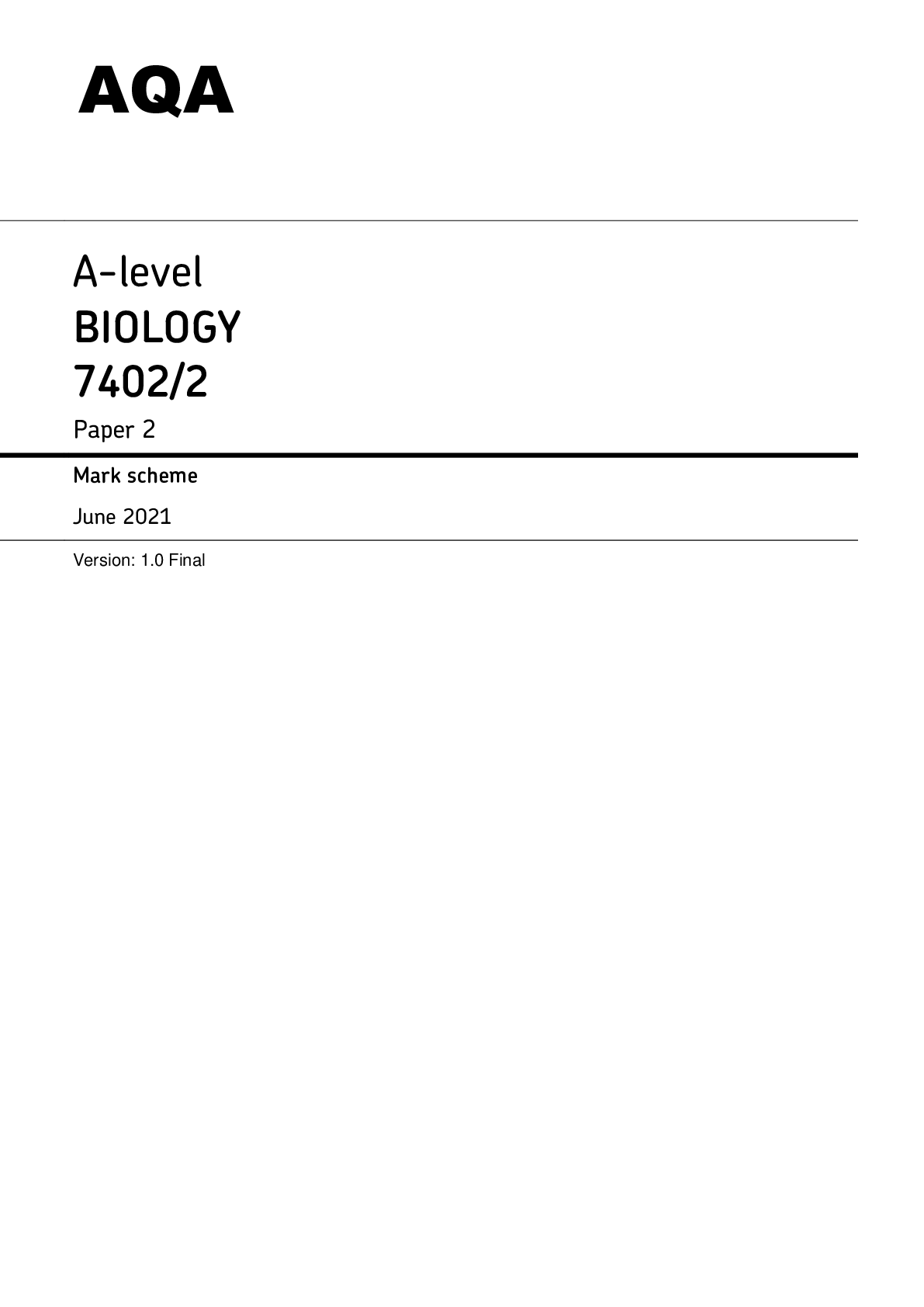
Buy this document to get the full access instantly
Instant Download Access after purchase
Buy NowInstant download
We Accept:

Also available in bundle (2)
Click Below to Access Bundle(s)
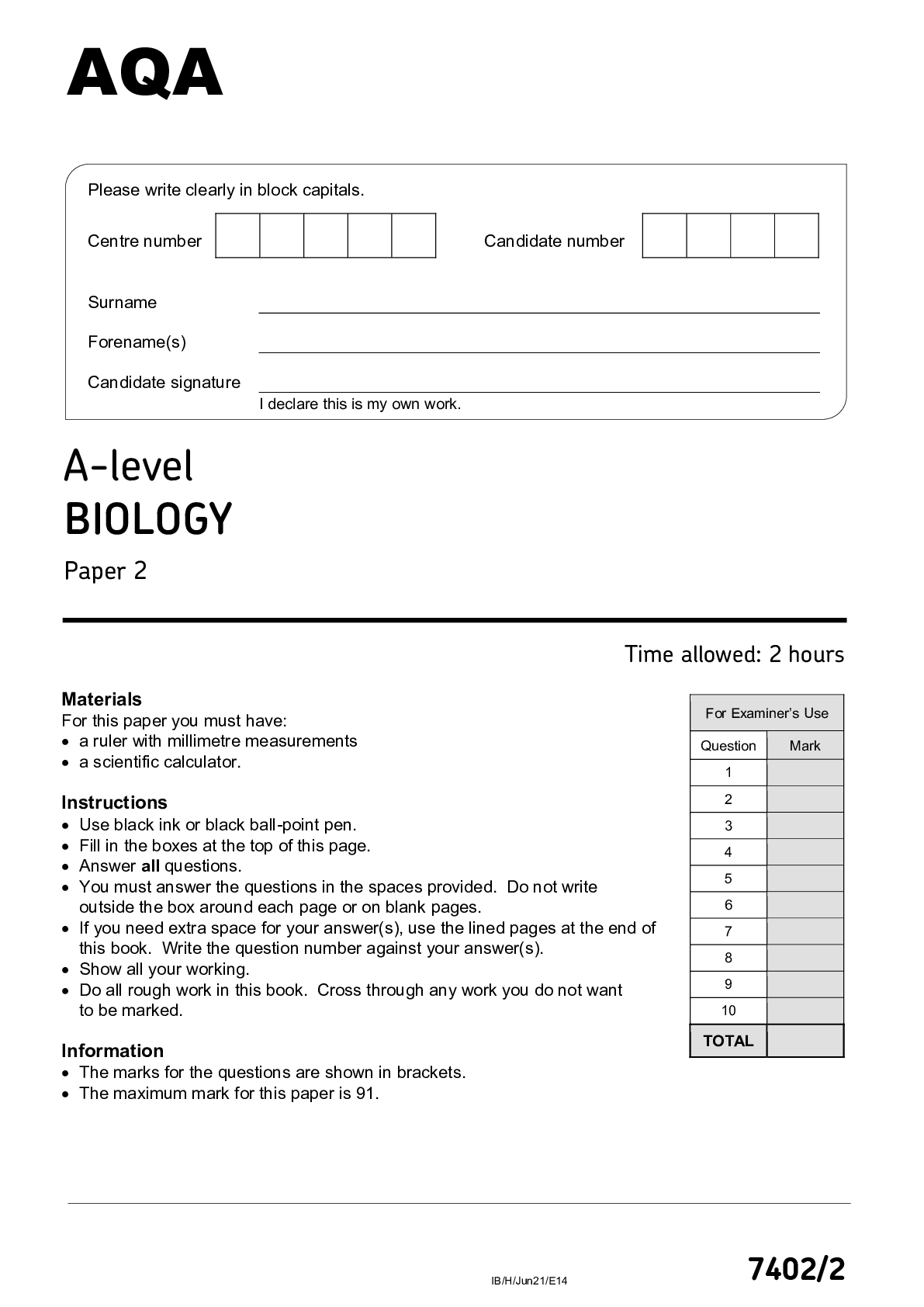
A Level Biology 7402/2 Paper 2 Question Paper & VERIFIED Mark Scheme June 2021
AQA A Level Biology 7402/2 Paper 2 Question Paper June 2021 AQA A Level Biology 7402/2 Paper 2 Mark Scheme June 2021 Version 1.0 Final
By Tests guru 3 years ago
$10
2
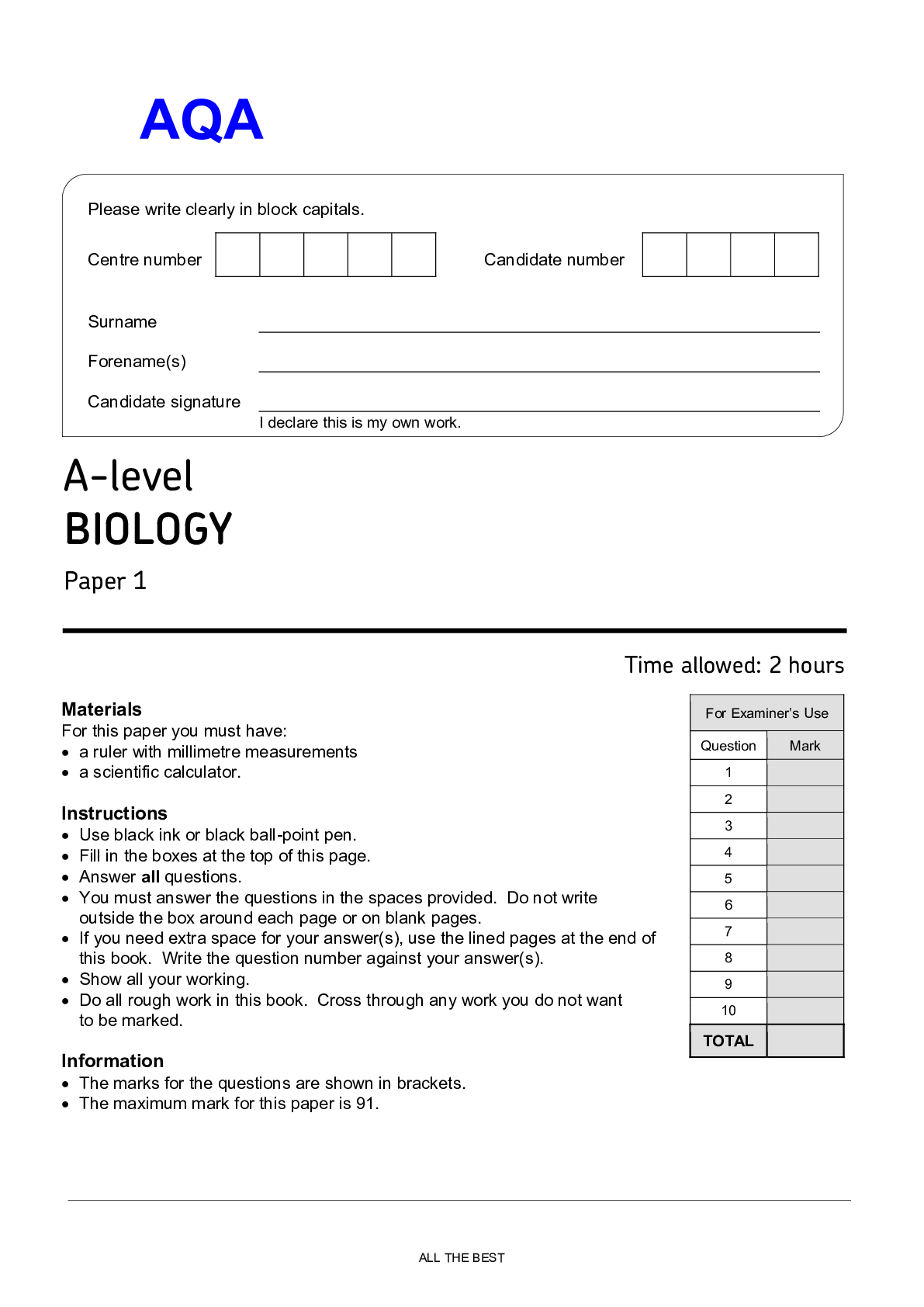
A Level Biology COMPLETE BUNDLE JUNE 2021 | Paper 1 (7402/1), Paper 2 (7402/2) and Paper 3 (7402/3) Question Papers With VERIFIED Mark Schemes
AQA A Level Biology Paper 1 7402/1 Question Paper June 2021 AQA A Level Biology 7402/1 Paper 1 Mark Scheme June 2021 Version 1.0 Final AQA A Level Biology 7402/2 Paper 2 Question Paper June 2021...
By Tests guru 3 years ago
$25
6
Reviews( 0 )
$7.50
Can't find what you want? Try our AI powered Search
Document information
Connected school, study & course
About the document
Uploaded On
Jul 06, 2022
Number of pages
16
Written in
All
Additional information
This document has been written for:
Uploaded
Jul 06, 2022
Downloads
0
Views
319





